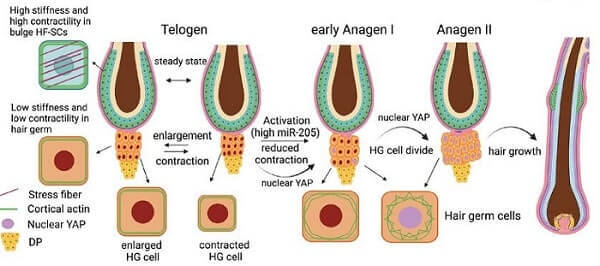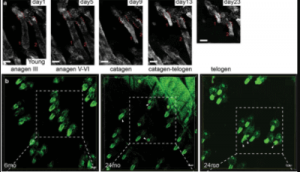Update: July 12, 2024
In a pleasant surprise, we have an update on miR-205 for hair growth. Apparently, human clinical trials are set to commence “immediately” and “straight way” according to Trinity professor Luke O’Neill. It seems like the trials may test tablets as well as a cream or topical ointment.
June 6, 2023
MicroRNA-205 (miR-205) Promotes Hair Regeneration
Last month, an interesting new study was published in PNAS that was titled “MicroRNA-205 (miR-205) promotes hair regeneration by modulating mechanical properties of hair follicle stem cells”.
It seems like hair follicle stem cells become stiff with age, just like the rest of your body. MicroRNA (miRNA) can reverse the stiffness and regrow hair, at least in mice. Make sure to also read my past detailed post on MicroRNA and hair growth.

Softening Stiff Hair Follicle Stem Cells Regrows Hair
This latest study was led by scientists from Northwestern University School of Medicine (US), with significant contribution from Singapore’s A*Star) too. Neuroscience News has a succinct summary on the findings (h/t “curious”). In essence:
- Hair follicle stem cells become stiff and hardened with age, thus hindering hair growth.
- Northwestern scientists have discovered a way to soften these stem cells by increasing the production of miR-205. This in turn promotes hair regrowth in mice.
- Future experiments will investigate if humans see similar hair growth results after the topical application of miR-205 on scalp hair. The delivery will be done by nanoparticles.
MicroRNA-205 and Hair Regrowth
When the researchers genetically manipulated hair stem cells to produce more of a “tiny RNA” termed miR-205, it promoted hair regrowth in both young and old mice. It did this via mild and reversible downregulation of many genes. This in turn relaxed the hardened cells and promoted cell cycle reentry and hair regeneration.
Moreover, per a quote from the corresponding author Rui Yi:
“These are not new stem cells being generated. We are stimulating the existing stem cells to grow hair. A lot of times we still have stem cells, but they may not be able to generate the hair.”
Interestingly, when people’s arteries get stiff with age, they get high blood pressure. Anti-hypertensive medications (such as oral Minoxidil) enable the relaxation of blood vessels. Topical Minoxidil also causes vasodilation (i.e., the widening of blood vessels).
